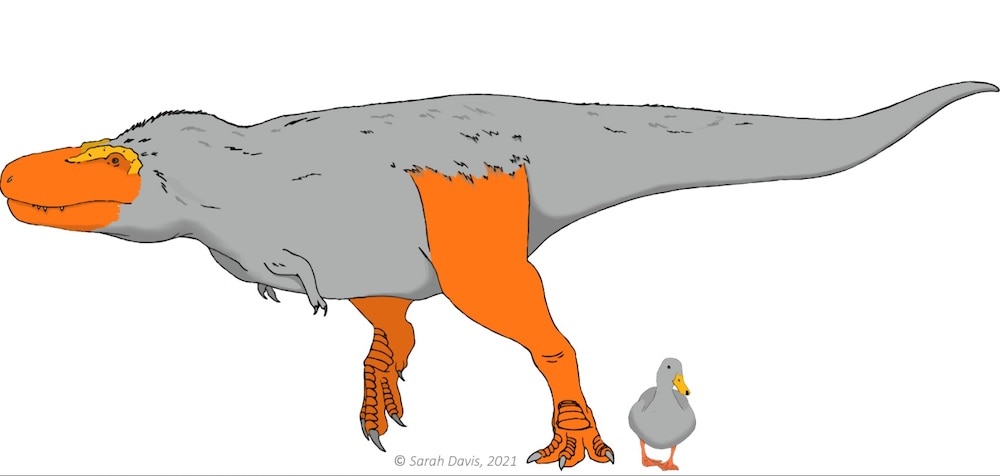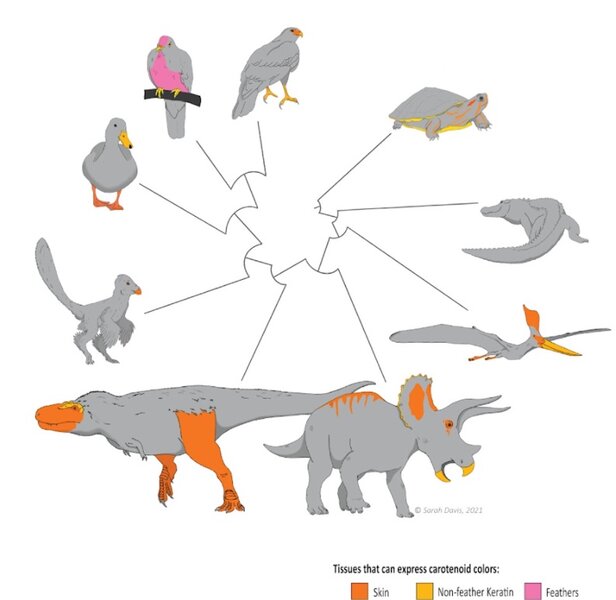Create a free profile to get unlimited access to exclusive videos, sweepstakes, and more!
Dinosaur fashion might have been more flamboyant than we thought
We like to imagine them trading looks and complimenting one another on their vibrant frills.

Our picture of dinosaurs has changed a lot over the last few decades. Animals which were once considered to be large, scaly, lizard-type creatures — essentially crocodiles twisted into various shapes — we now know to be much more interesting.
First, there was the discovery that feathers may have been much more apparent across the dino spectrum, transforming our favorite terrible lizards into something closer to modern birds. Now, according to a recent paper in the journal Evolution by Sarah Davis and Julia Clarke from the School of Geosciences at the University of Texas, there’s good evidence to suggest that dinosaurs’ non-feathered areas were chock-full of bright colors.
Determining the coloration of extinct animals from the fossil record is difficult largely because those colors first have to be maintained throughout the animal’s life and then become preserved. That only happens with certain colors and other certain conditions.
“There is fossil evidence for muted colors, that’s because the structure of the pigment-producing cells that make those colors are actually pretty stable,” Davis told SYFY WIRE. “In ideal fossilization conditions those color-producing organelles do preserve and based on the shape of those cells we can interpret potential color.”
Brighter colors, however, are less stable even in the bodies of living animals. Hues like orange and red break down from interaction with the environment and may not persist even throughout the entirety of an animal’s life, let alone stick around to be fossilized.
To get around this problem, scientists reconstructed the state of extinct animals by looking at their living relatives and working backward.
“We used a phylogenetic tree — an existing hypothesis of relationships between living and extinct animals — and then used a bunch of different models of evolution to fit our data onto that phylogeny,” Davis said.
The process doesn’t provide a surefire answer to whether bright colors existed in extinct animals like dinosaurs, but it does provide for estimates of probability. To get the most robust estimates, the team included 4,000 species of living birds as well as turtles and crocodiles. Combined, those animals cover the closest relationships to extinct dinosaurs.
When the numbers were crunched, they estimated a 50% probability of bright coloration in skin, scales, and beaks — areas which are not covered in feathers. If the coloring did exist, it’s likely it was used to communicate individual health as well as sexual messaging.
“In living animals that use this kind of coloration, it has a bunch of different functions. In a lot of cases, especially with birds, it is a sexual signal. Bright yellows, reds, and oranges are thought to be a signal that can tell potential mates about the fitness of that animal,” Davis said.
That’s because these pigments aren’t an inherent quality of the animal. Instead, it is obtained through an animal’s diet, much like the pink color of modern flamingos which comes from the shrimp they eat. In order for an animal to exhibit these bright colors, they must be successful in acquiring the right nutrients, processing them, and delivering the pigments into their tissues. A lack of color could signify a breakdown in one or more parts of that process, telling a potential mate to look elsewhere.
For an idea of the sorts of colorations we might expect in extinct dinosaurs, we need look no further than the cassowary, a large flightless bird endemic to Papua New Guinea, Indonesia, and parts of Australia.
Cassowaries exhibit intense coloration on their necks and heads, while their feathers are comparatively dull. Similarly, scientists believe coloration in extinct dinosaurs was limited to non-feathered regions of the body as opposed to having the brightly colored feathers we see in many modern bird species.
“We don’t even see colored feathers in ancestral birds,” Davis said. “It seems like this kind of coloration in feathers is bird-specific and evolved in birds a bunch of different times. It might have been energetically easier to deposit these types of colors in skin and the selective pressure might not have been there in extinct dinosaurs.”
Pending further evidence, whether or not extinct dinosaurs were brightly colored is currently a coin toss, but we choose to believe they were out there strutting their stuff on the Jurassic runway, legs and faces ablaze.



























